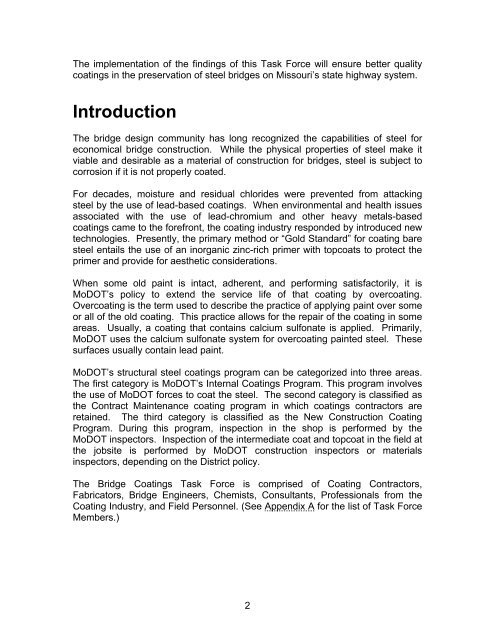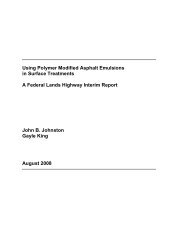An Evaluation of MoDOT's Current Coatings Programs Final ... - TSP2
An Evaluation of MoDOT's Current Coatings Programs Final ... - TSP2
An Evaluation of MoDOT's Current Coatings Programs Final ... - TSP2
Create successful ePaper yourself
Turn your PDF publications into a flip-book with our unique Google optimized e-Paper software.
The implementation <strong>of</strong> the findings <strong>of</strong> this Task Force will ensure better quality<br />
coatings in the preservation <strong>of</strong> steel bridges on Missouri’s state highway system.<br />
Introduction<br />
The bridge design community has long recognized the capabilities <strong>of</strong> steel for<br />
economical bridge construction. While the physical properties <strong>of</strong> steel make it<br />
viable and desirable as a material <strong>of</strong> construction for bridges, steel is subject to<br />
corrosion if it is not properly coated.<br />
For decades, moisture and residual chlorides were prevented from attacking<br />
steel by the use <strong>of</strong> lead-based coatings. When environmental and health issues<br />
associated with the use <strong>of</strong> lead-chromium and other heavy metals-based<br />
coatings came to the forefront, the coating industry responded by introduced new<br />
technologies. Presently, the primary method or “Gold Standard” for coating bare<br />
steel entails the use <strong>of</strong> an inorganic zinc-rich primer with topcoats to protect the<br />
primer and provide for aesthetic considerations.<br />
When some old paint is intact, adherent, and performing satisfactorily, it is<br />
MoDOT’s policy to extend the service life <strong>of</strong> that coating by overcoating.<br />
Overcoating is the term used to describe the practice <strong>of</strong> applying paint over some<br />
or all <strong>of</strong> the old coating. This practice allows for the repair <strong>of</strong> the coating in some<br />
areas. Usually, a coating that contains calcium sulfonate is applied. Primarily,<br />
MoDOT uses the calcium sulfonate system for overcoating painted steel. These<br />
surfaces usually contain lead paint.<br />
MoDOT’s structural steel coatings program can be categorized into three areas.<br />
The first category is MoDOT’s Internal <strong>Coatings</strong> Program. This program involves<br />
the use <strong>of</strong> MoDOT forces to coat the steel. The second category is classified as<br />
the Contract Maintenance coating program in which coatings contractors are<br />
retained. The third category is classified as the New Construction Coating<br />
Program. During this program, inspection in the shop is performed by the<br />
MoDOT inspectors. Inspection <strong>of</strong> the intermediate coat and topcoat in the field at<br />
the jobsite is performed by MoDOT construction inspectors or materials<br />
inspectors, depending on the District policy.<br />
The Bridge <strong>Coatings</strong> Task Force is comprised <strong>of</strong> Coating Contractors,<br />
Fabricators, Bridge Engineers, Chemists, Consultants, Pr<strong>of</strong>essionals from the<br />
Coating Industry, and Field Personnel. (See Appendix A for the list <strong>of</strong> Task Force<br />
Members.)<br />
2
















